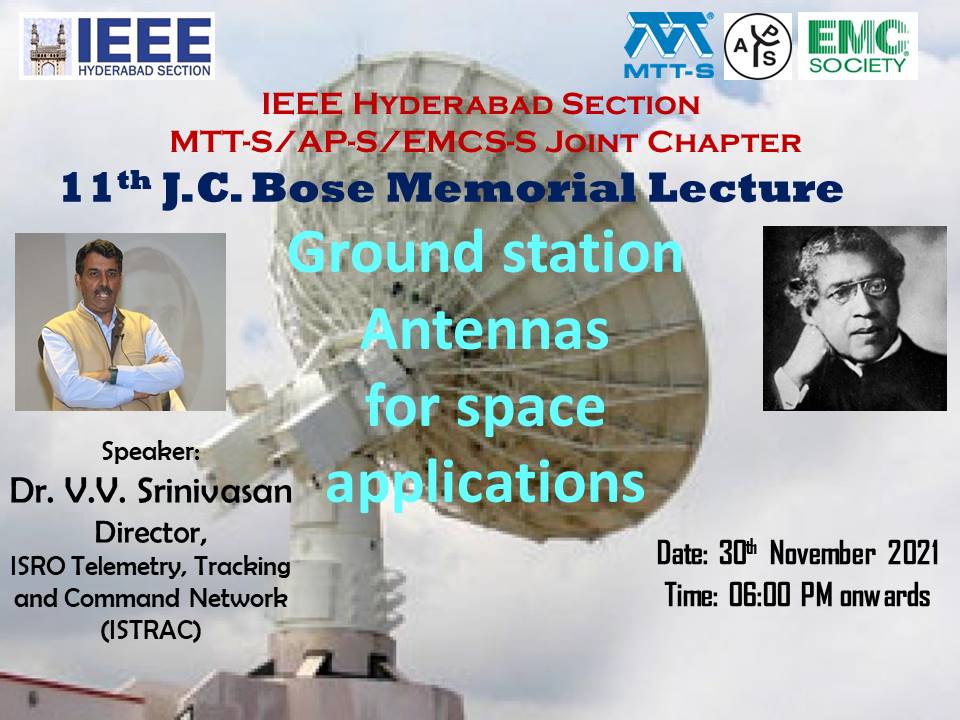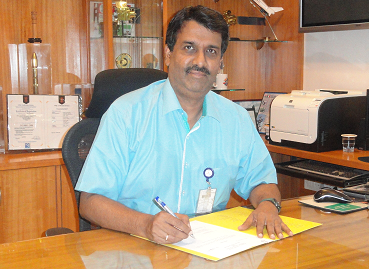MTTS/APS/EMCS J.C. Bose Memorial Lecture
IEEE Hyderabad Section & MTT/AP/EMC Joint Chapter present the annual flagship event of 2021

11th J.C. Bose Memorial Lecture on "Ground station Antennas for Space Applictions"
Date and Time
Location
Hosts
Registration
-
 Add Event to Calendar
Add Event to Calendar
- Hyderabad
- Hyderabad, Andhra Pradesh
- India 500058
Speakers
 Dr. V.V. Srinivasan of ISRO Telemetry Tracking and Command Network (ISTRAC), ISRO, Bangalore
Dr. V.V. Srinivasan of ISRO Telemetry Tracking and Command Network (ISTRAC), ISRO, Bangalore
High Efficiency, Multi Function Ground Station Reflector Antennas
Ground stations are one of the important elements of space applications. They play the role of ear and mouth of the satellite control centres and additionally provide payload services. Reflector antennas have been used widely in the ground stations to transmit or receive signals from satellites. As various bands are used for remote sensing and communication satellites they are deployed in tune with the requirement. Communicating with satellites orbiting planets in the solar systems is highly challenging due to the long distances involved and calls for the deployment of very large antennas. As every fraction of a dB matters in the communication link, effort is made to improve the antenna gain by various techniques simultaneously decreasing the insertion loss in the system, thus resulting in the improved performance of the figure-of-merit, the G/T of the ground station antenna. It also becomes important that a given antenna supports both uplink and downlink operations preferably in many allocated frequency bands so that the space operations become cost effective. Reflector antennas are ultra wide band system and the main and subreflector can maintain excellent performance over multi octave bandwidths. This makes it very attractive and right from the start of satellite era, reflectors antennas have been integral part of the space applications system. Many important technologies are developed and deployed over the years and have been providing critical mission support to various missions. Some of the technologies to improve the efficiency of the reflector system will be discussed in the talk. Similarly to reduce the insertion loss, reflector antennas used in deep space network employs complex and versatile Beam Waveguide systems. As the space exploration continues to expand, there is a need to explore farther planets with suit of payloads demanding high data rate links. This calls for a thousand fold increase in performance with respect to the current day systems. Array of reflector antennas combined with advances in high speed signal processing techniques is a very interesting, cost efficient and viable solution to future missions. The salient features and typical configurations of DSN arrays will also be covered.
Biography:
Dr V.V. Srinivasan, Outstanding Scientist, Director, ISTRAC/ISRO obtained his M.Tech degree in Microwave Electronics from Delhi University, India, in 1986 and Ph.D from University of Rajasthan, India, in 2017.
He joined the Communication Systems Group of U. R. Rao Satellite Centre, Bangalore in the year 1986 and was heading the same before moving to ISRO Telemetry Tracking and Command Network (ISTRAC), Bangalore, in the year 2016. He is involved in the development of antennas for spacecrafts, airborne radar applications and ground station antennas. His area of research includes phased array antennas for spacecraft applications, microstrip antennas and arrays, high efficiency – light weight reflector antennas, broadband antennas, ground station antennas, feeds for reflector antennas. Space-borne Phased Array Antennas with dual circular polarization capability designed by him have been flown and widely used to transmit high quality images in state of the art remote sensing satellites. One of his important contributions is in the design and realization of ISRO’s 32m diameter ground station antenna with beam waveguide (IDSN-32). He is currently the Director of ISTRAC which is entrusted with the major responsibility to provide tracking support for all the satellite and launch vehicle missions of ISRO. He has published more than 110 technical papers in various national / international conferences and journals.
Dr. Srinivasan is a recipient of National Research Development Corporation (NRDC), India award in 1998 for a novel antenna feed development and IETE’s Prof. S. N. Mitra Memorial Award in 2002. He is a member of the team that received ‘Team Excellence Award-2007’ of ISRO for his contribution in the design of IDSN-32 and Phased Array Antenna and ‘Team Excellence Award-2014’ for the development of Communication systems for Mars Orbiter Mission.
He is an active IEEE volunteer and served the Bangalore section in various capacities and chaired the section in 2010 and 2011. He is a Senior Member of IEEE.
Email:
Address:ISRO Telemetry Tracking and Command Network (ISTRAC), Peenya Inductrial Area, Bangalore, Karnataka, India, 560058
Agenda
1. Introduction
2. Welcome address by Hyderbad section chair
3. Remarks by Hyderabad section Secretary
4. Remarks by Dr. M. Lakshminarayana (Past Chair Hyderabad Section)
5. Brief on chapter activities of by MTT-S/AP-S-EMC-S Joint Chapter Chair
6. Introduction to Speaker and topic
7. J.C. Bose Memorial Lecture on "Ground Station Antennas for Space Applications" by Dr. V.V. Srinivasan
